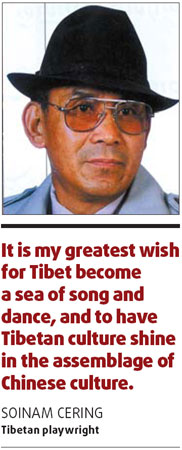Playwright determined to keep folk arts alive
(China Daily)
Updated: 2008-04-22 07:04
Updated: 2008-04-22 07:04
In Tibet, most people are unaware of the works of William Shakespeare, but mention the name Soinam Cering and almost everyone will be able to name at least some of his crosstalk dramas.
Always seen wearing his trademark leather hat, the 63-year-old is known as the first playwright in the Tibetan language, the compiler of the first record of folk vocal art in Tibet and one of the initiators of Tibetan crosstalk.

He first showed his versatility in folk arts at primary and middle schools in Tibet, then later as a student at the Shanghai Theater Academy.
He said he could never help wondering why there were no Tibetan playwrights.
"I asked myself, can we find a way to rejuvenate our traditional dramas?"
Inspired by the vast ocean of folklore in the plateau region, Soinam Cering wrote the six-scene Romeo and Juliet-style tragedy Saigyi and Baigyi.
The story told the story of ill-fated lovers Saigyi, a blacksmith, and Baigyi, the daughter of a landlord. Saigyi was killed when he failed to rescue his lover and Baigyi committed suicide. The pair became two beautiful birds crying Saigyi Baigyi and flew into the sky.
The drama stirred Tibet and was a big success in the early 1980s. It was performed more than 30 times, attracting a combined audience of about 120,000.
His second work Ngagu Dainba, which he completed in 1981. It told of an intelligent, humorous and brave Tibetan unyielding to an evil landlord.
"In Xinjiang they have the legend of Naiserden Atainde. In Tibet, we also have our own folk hero," Soinam Cering said.
The comedy was the peak of his work as a playwright. It has been performed 100 times consecutively in Lhasa, a record in the performance history of the autonomous region.
"Many people from other counties traveled to Lhasa by bus especially for the show, and returned the next day," the playwright said.
In 1988, Soinam Cering started to compile a record of Tibetan folk vocal art.
"I thought it would be no big deal at the time," Soinam Cering said.
The project took him 17 years to finish.
In that time, Soinam Cering visited almost every county in Tibet and met more than 200 folk artists.
Luck played its part in trying to find the artists, he said.
"During the years, we had some unexpected excitement, but most of the time, disappointment," he said.
On one occasion, Soinam Cering had a scary encounter on an old wooden bridge in Nyingchi.
"As we drove over the middle of the bridge, we could hear it breaking. We were so scared that nobody dared to speak for fear of adding weight to the vehicle.
"When we finally got across, we looked back and saw the deep valley below us. Sweat was dripping down our faces," he said.
In 1995, when he was recording a religious performance of monks at the Sanyai Monastery, thought to be the first monastery in Tibet, he was hit by a sandstorm.
"Sand went into my right eye, but I didn't pay attention to it," he said.
Later, Soinam Cering's eye felt uncomfortable. He thought it was a natural result of fatigue as he had been writing more than 10 hours a day.
Nine years later when he had a business trip to Beijing, he went to Tongren Hospital where doctors told him his cornea was damaged.
One of the artists Soinam Cering was looking for eluded him for 40 years.
"I first saw her when I was in primary school. She was dressed like a nun and performing in front of a tangka (mural) at a square in Lhasa," he said.
The artist was Cering Qoinzom who was part of a performing family.
"Her uncle was liked by the 13th Dalai Lama, who gave him a tangka of Princess Wencheng, the princess in the Tang Dynasty who married Songtsan Gambo, king of the Tubo Kingdom," Soinam Cering said.
With his record now complete, Soinam Cering has a new goal.
"I am going to compile a Chinese-Tibetan dictionary of folk arts so that more people can understand and appreciate Tibetan culture," he said.
He also wants to do something to promote the development of Tibetan folk arts.
"Folk arts in Tibet are in their golden era now for development. The central government has spent lots of money and energy on their resurrection."
However, like other traditional art forms in China, Tibetan folk arts faced a talent shortage, he said.
"Many famous artists, like singer Tseten Drolma and crosstalk performer Tubdain, are growing old and don't have apprentices," he said.
"It is my greatest wish for Tibet become a sea of song and dance, and to have Tibetan culture shine in the assemblage of Chinese culture," he said.
|
||
|
||
|
|
|
|